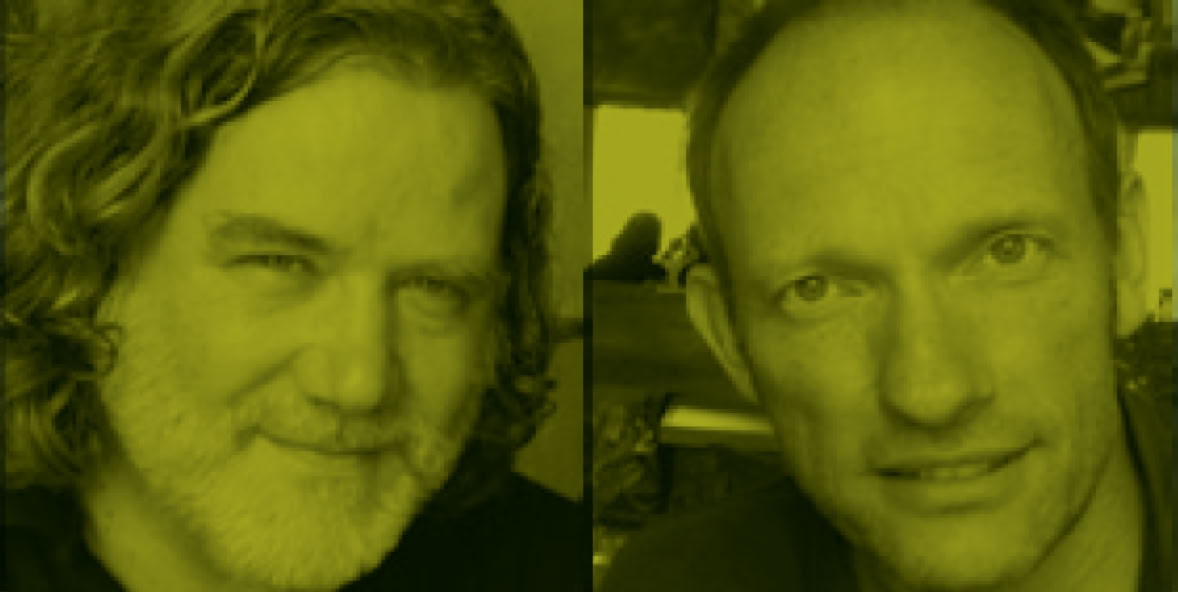CATALOG nemu 013

Albrecht Maurer -
violin, viola, voice
Norbert Rodenkirchen -
transverse flute, alto flute
contact / booking:
Recorded April 2013 at Kreuzkirche Mülheim/Ruhr. Mastered by Reinhard Kobialka, Topaz Studio, Cologne. Layout concept by Christiane Resch, cover photo "Loplop and Dorothea Converge in Sedona" by Deborah McMillion Nering, duo photo by Matthias Creutziger. Produced by Albrecht Maurer & Norbert Rodenkirchen. 2013
Duality comes in many forms – opportunities to compare and contrast. The interaction of a duo, in consonance, in conflict, in call and response. The duo of Albrecht Maurer and Norbert Rodenkirchen, on a variety of fiddles and flutes respectively, are free to carry on the flying dialogue of wind and bird liberated from the earthly constraints of a rhythm section. The duality of art and music. As in their previous Nemu release Hidden Fresco which drew on visual imagery and whose title was suggested by a quote from Leonardo Da Vinci, Albrecht and Norbert have taken inspiration from the visual arts – in particular the painter, sculptor and collagist Max Ernst. Like many surrealists, Ernst explored the duality of conscious life and dream states and discovered that for himself, birds were both a familiar animal and an alternate persona.
This led to Ernst's lifelong fascination with birds and recurring representations of the character of Loplop (The Superior of Birds) who acted both as a muse and an instantiation of his own dual nature. Loplop lends his musical persona here in a suite of pieces interspersed throughout the program. Loplop's Call is an invocation - it begins with a sly beckoning and gradually becomes more insistent refusing to be ignored. Die Windsbraut (The Bride of the Wind) is the woman who often accompanies Loplop in many images such as the one on the cover of the CD. Maurer introduces her with a questioning figure which Rodenkirchen picks up as a dance and after an alternately spritely and somber interlude, they conclude with the dance in unison. Ernst said that the Dadaist movement, of which he was an early member, was the only rational response to the insanity of war. Art was the only mechanism for forgetting (Pour oublier) the horrors of the conflict that he experienced as a gunner in the first world war. Rodenkirchen´s short piece uses wounded echoes ending in a melancholy melody. Ernst also explored the duality of the real and spirit world in his collection of Kachina dolls - Pueblo dolls who represent hidden spirits. The spirits here in Maurer's composition are gamboling and playful, expressive and thoughtful, parallel to the Kachina concept of pantheism - the presence of life in all objects that fill the universe. Maurer has also applied a musical equivalent of Ernst's technique of frottage to a Turkish folk song which he had previously played in an incarnation of the great vibraphonist Karl Berger's ensemble. Ernst admired the grain in a textured wooden floor and used a frottage or rubbing to lift the texture which he incorporated into the background of some of his paintings. Maurer has extracted various of the underlying elements - pitches and rhythms - of the song to produce his composition Whatever Met My Ear. He and Rodenkirchen reprise the original in a haunting performance of the Turkish folk song Zeynebim.
The duality of the modern and the ancient. Although Maurer and Rodenkirchen are renowned interpreters of ancient music - Rodenkirchen through his celebrated work with Sequentia and Maurer on gothic fiddle through groups such as Ensemble Dialogos - they both have numerous collaborations with contemporary creative musicians around the world. Accordingly although both play their period instruments in addition to their modern ones, they have eschewed the older ambiance for a sound more in keeping with the rest of the early 20th century context they've drawn on for inspiration. Some of the interactions and figures are more reminiscent of Janacek and Kodaly than the ancient or modern contexts for which they're best known. The duality of the composed and the improvised. Like the seasoned composers and improvisers that they are, Albrecht Maurer and Norbert Rodenkirchen leave enough space in their pieces for spontaneous interaction. It all culminates in Peggy - the purely improvised performance that ends with the same flourish that introduced the opening call and unites the duality of their dialogue into a satisfying whole.
Nou Dadoun, Vancouver, September 2013